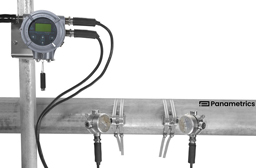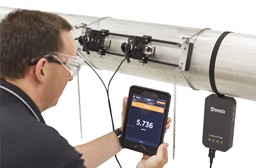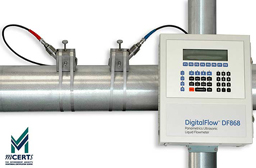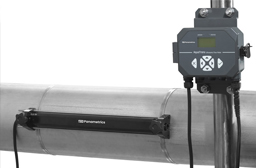Maximising Efficiency: Clamp-on Flowmeters Vs. In-line Systems in Advanced Flow Measurement
Numerous pipe flowmeter systems rely on technology that comes into contact with fluid in order to measure flow. However, given the inherent potential for failure in such technologies, opting for non-contact alternatives becomes imperative. When confronted with the inevitability of technological breakdowns, the compelling reasons to embrace non-contact technology become glaringly apparent.
Flowmeter technologies are varied and some technologies have been in use for decades, even centuries. In recent years, the need to measure fluid flow inside of pipes has increased and as a result so have the technological advancements available. Whilst some simple technologies are still widely used, there are some issues that arise when technology is directly exposed to fluid flows.
Clamp-on ultrasonic flowmeter systems consist of sensors which measure flow from the outside of the fluid process pipe wall. This technology has been in continuous development since the late 1950s. There are several benefits of using clamp-on ultrasonic technology over other technologies that rely on direct contact with fluid:




#1 A fully external measurement system allows for the following scenario when installing, commissioning and maintaining the system. There simply is no pipe or fluid process shutdown, no drainage of the fluid inside of the pipe, no resources and time required to install the 'sensor body' and process connections, no fluid refill and no overall process downtime or shutdown. A clamp-on sensor can be installed on a process pipe without any modification to the actual pipe what-so-ever, saving time and money to install.
#2 Calibration and flow verifications are more straight forward too complete, as calibration-test flowmeter systems can be installed in close proximity to the clamp-on flowmeters. Clamp-on systems require very little space to place onto pipes. Any issues with calibrations and verifications can usually be sorted quickly and inexpensively with a change of cable, rather than replacing the whole system, which is an issue with in-line systems failing calibration.
#3 Clamp-on ultrasonic flowmeters can measure a variety of different fluids, so long as the fluid is acoustically conductive. This means that water is not only able to be monitored, but other fluids such as hydrocarbon fuels, additive solutions such as ad-blue, de-ionised water, water-glycol mixes, wastewater and many more fluids can be measured using clamp-on ultrasonic flowmeter systems. Furthermore, pipe materials that are acoustically conductive, such as commonly used variants of stainless steel, ductile iron and plastic can also have clamp-on systems fitted to the pipe. For a list of suitable fluids and materials, see https://www.rshydro.co.uk/sound-speeds/.
#4 Clamp-on ultrasonic flowmeter systems are highly customisable, meaning that they can measure in a variety of different locations and conditions. It is possible to select a simple system for use in an indoor dry environment. However due to different available options for cable weatherproofing and submergibility as well as ingress protection for the sensors and electronics, a clamp-on ultrasonic system can also be deployed outside or in an area that floods. There are also hazardous area rating specifications available, with armoured fire resistance co-axial cable and electronics that are suitable for use in ATEX rated areas.
#5 Some clamp-on ultrasonic flowmeter systems are suitable for applications that require meeting monitoring standards, such as MCERTs or SIL safety rating. This means that projects that require high accuracy measurement to protect the environment or assets which the system is monitoring can use a clamp-on ultrasonic flowmeter.
#6 Clamp-on systems do not increase in cost as a function of the size of the pipe diameter. This means that for large pipe diameters, it is cheaper and more beneficial to use a clamp on than it would be to use a large diameter sensor body. It will also be cheaper to rectify issues with large diameter measurement systems. Delivery costs are kept low too.
#7 Lead times to manufacture and produce clamp-on flowmeter systems are faster than larger diameter in-line systems, due to the simplicity of clamp-on systems and lack of an insertion sensor body.
#8 Clamp-on systems have replaced in-line technologies which have failed on existing process pipe.
These represent just a handful of compelling rationales for adopting an external pipe flow measurement system, particularly when focused on medium and long-term monitoring. Panametrics produce reliable systems that are designed to function for the long-term, meaning that cost of maintaining and running a clamp-on ultrasonic system is minimal.
To explore the seamless transition to clamp-on technology, chat to the experts from RS Hydro's clamp-on sales team.
